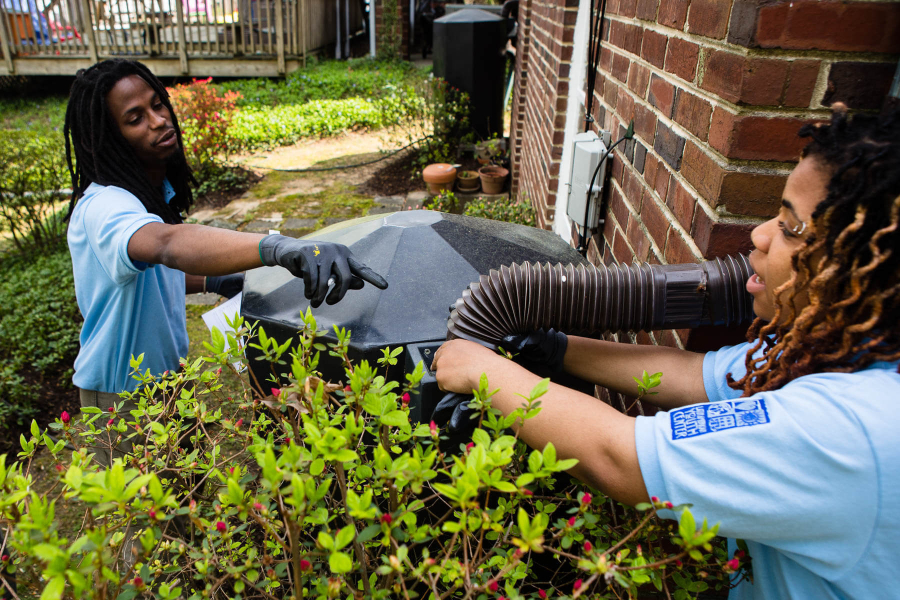Harvesting the rain
Combat pollution at home by collecting your own rain water

Rainy days can make us want to curl up inside with a good book or thrilling Netflix show, but they also create the issue known as stormwater runoff.
Stormwater runoff is rain that runs across the land, picking up pollutants as it goes—everything from lawn fertilizers and pet waste to motor oil and litter. It is carried into nearby rivers and streams instead of reentering the water cycle by evaporating or soaking into the ground.
Different types of pollution from stormwater runoff can cause various types of issues once it reaches a river or stream.
- Excess nutrients are responsible for harmful algal blooms.
- Chemical contaminants are dangerous for the health of humans and wildlife.
- Sediment can suffocate shellfish and block sunlight from reaching underwater grasses.
Additionally, as stormwater surges, it can erode stream banks and other aquatic habitats.
Stormwater runoff is the fastest growing source of pollution impacting the Chesapeake Bay. In 2017, stormwater runoff was responsible for approximately 20% of all nitrogen and 20% of all phosphorus pollution flowing into the Bay.
On top of that, both the amount of rain and the frequency and magnitude of flooding is increasing because of climate change, which exacerbates the problem of stormwater runoff. The majority of the Chesapeake Bay region has seen an increase in total annual rain between 1901 and 2017. The number of storms with extreme precipitation across the country has increased 24% since 1948.
Prevent stormwater pollution with rain barrels
Since we can’t stop the rain from falling and water from flowing, what can we do to combat stormwater runoff? We can collect and store some of that water in rain barrels: large containers designated for collecting and redistributing rainwater.
There are many benefits to installing a rain barrel on your property.
- Prevent flooding: Using a rain barrel to divert excess water away from your house helps preserve your home’s foundation and reduces the load on your sump pump, which can prevent flooding.
- Reduce erosion: Rain barrels can also reduce the soil erosion that occurs after a heavy rain event.
- Prevent pollution: By collecting some of the water running off your roof and into your yard, rain barrels reduce the amount of stormwater flowing to the Bay.
Rain barrels can hold between 55 and 90 gallons of unfiltered water, and while it isn’t safe to drink or use for watering edible plants, it still serves a variety of non-potable purposes. Depending on the design, you can save an average of 1,300 gallons of water each summer.
You can use rainwater to:
- Water ornamental plants or lawns.
- Wash cars, pets, driveways and sidewalks.
- Refill fountains and fish ponds.
There are tools available for calculating the amount of rainwater your rain barrel will collect. You can find the annual average rainfall in your area through your local weather station, and measure the square footage of your collection surface (your roof). Once you’ve found these values, you can plug them into a rainwater collection calculator to determine how much water your rain barrel can hold. This information can help you plan how you can use your collected water.
Setting up and maintaining your rain barrel
Your rain barrel can’t do its job if it’s not set up correctly or maintained, and there are a few things to keep in mind to make sure it is set up and functioning properly.
Connect your rain barrel to a downspout.
Without connection to a downspout, rain barrels have less capacity to capture the water flowing from roofs to the pavement and can only capture the rain falling directly from the sky.
Make sure your rain barrel does not drain onto hard surfaces.
Impervious surfaces like driveways, sidewalks or street gutters funnel overflow water into storm drains.
Prevent pests.
When rain barrels are left open, they create stagnant pools of water—the perfect breeding ground for mosquitoes. You can prevent this by using a closed barrel system and tight-fitting connections and covering any openings with a fine mesh screen.
Prevent algae.
Algae is caused by light, debris and dirt. Using a dark-colored, painted or opaque barrel and putting it in the shade will limit light and help prevent algal growth. By annually cleaning both your gutters and the barrel, you can reduce the amount of dirt in your rain barrel. You can also install gutter screens to block any plant debris, dirt or animal droppings from entering the barrel.
While rain barrels require occasional maintenance, the work will pay off when you can help prevent flooding and easily water your plants, all while protecting our water.
Many local home and garden centers sell rain barrels or you can make your own.

Comments
There are no comments.
Thank you!
Your comment has been received. Before it can be published, the comment will be reviewed by our team to ensure it adheres with our rules of engagement.
Back to recent stories